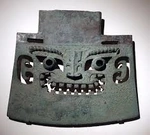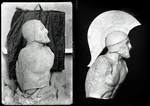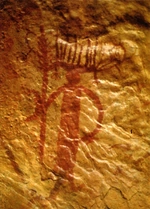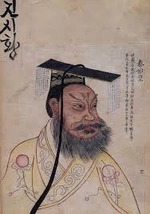Shang Dynasty: State Structure, And Mesurements
Our time machine bearing us to the more distant period of Chinese historiography, and respectfully, to another cultural epoch.
By the way, have you noticed that space itself is tightly related to time, as to physical matter? Those two are interwoven with each other, and as a result, our landing location has slightly offset us too.
Now we are in the Shang Dynasty period, and this is the walking time across the state.
⛩️ Shang Dynasty: State Structure and Feudal Order

Historical Context and Governance Foundations
- The Shang dynasty succeeded the semi-legendary Xia and preceded the Zhou, ruling in the middle and lower Yellow River valley, with its capital at Yin (modern Anyang) in its later phase.
- The Shang period represents the formation of the earliest verified state system in China, characterised by hereditary kingship and divine legitimacy, decentralised regional administration through kin-based lords, the emergence of ritual bureaucracy and bronze-age urban centres.
- The king (王, wang) stood at the apex, serving simultaneously as political ruler, military commander, and high priest — the intermediary between the human world and the ancestors.
State Principles and Administrative Logic
For generalisation purposes (as we love), let's assemble the set of fields that will serve us as the basis for the state-managing tools concentrated within the ruler, and necessary for the successful governance of the state.
- Theocratic Monarchy (in shape, but read 'Monarchy'): The Shang king was believed to communicate directly with ancestral spirits through divination (oracle bones), making governance an extension of religious authority.
- Political power (ritual legitimacy).
- Kinship Governance (宗法制度, zongfa zhidu): The realm was divided among royal kin and trusted generals. These feudal lords governed territories nominally under the king’s mandate but retained strong local autonomy → Early form of feudal decentralisation, based on bloodline loyalty rather than bureaucratic appointment.
- Tributary Relations: Regional lords were required to send tribute (贡, gong) — grain, jade, bronze, and captives — reinforcing dependence on the royal centre.
- Military Integration: Armies were raised regionally; the king maintained control through rotational campaigns, ensuring feudal lords remained militarily subordinate.
- Ritual and Record-Keeping: The Shang maintained a central archive of oracle bone inscriptions, which served as both religious records and administrative tools — tracking harvests, tributes, and omens.
Here we will expose to our honorable reader the Shang Feudal acrheticture, with listed all major actors of the play, and as the sneck will propose our auditory to review and compare this social construction with medieval european commonly built feudalistic design.
Major Feudal Domains and Their Distinctions Shang Period
The well known for european reader definition of the County, may be implemented to the reviewing period, but for more accurate reviewing, will be as well author foun appropriately devide the state to more larger units territorialy first
🗡️ The Royal Core (Yin / Anyang):
- Characteristics: political and ritual capital, dense concentration of elite tombs and workshops, controlled redistribution of bronze, jade, and weapons — evidence of centralised resource control.
🗡️ Eastern Domains (Henan–Shandong region):
- Governed by royal kin; major centres such as Zhengzhou and Yanshi, economically vital for agriculture and metallurgy, maintained close religious ties with the capital through shared ancestor cults.
🗡️ Western and Frontier Domains (Shaanxi, Shanxi):
- Semi-autonomous; often included non-Shang populations integrated through alliance or subjugation, provided frontier defence and horses, less ritual integration — more militarised governance model.
🗡️ Southern Tributaries (Huai River basin):
- Ethnically diverse; governed through vassal chieftains (fang bo), contributed exotics (tortoiseshell, ivory, feathers) used in divination and ritual display.
Anf final review, enriches the picture with comprehanceness of the hierarchy design
While the Shang state was not “feudal” in the later Zhou sense, it featured proto-feudal characteristics — regional hereditary domains tied by kinship and allegiance.
| Rank / Role | Chinese Term | Function | Characteristics |
|---|---|---|---|
| King | 王 (Wang) | Supreme ruler, priest, military commander | Unified ritual and military power; presided over ancestor cult; issued divinations for state affairs |
| Great Lords / Princes | 諸侯 (Zhu hou) | Semi-independent regional rulers (royal kin) | Held hereditary fiefs; led local armies; obligated to tribute and military service |
| Vassal Chiefs | 方伯 (Fang bo) | Local clan chiefs or allied rulers on periphery | Managed frontier regions; intermediaries between the Shang and tribal groups |
| Military Commanders | 師 (Shi) | Generals drawn from nobility | Commanded royal and regional armies; often ritual figures as well |
| Clerical–Ritual Officials | 卜人 (Bu ren) | Diviners and scribes | Conducted oracle bone divinations; maintained ritual calendars and royal archives |
| Artisans / Bronze Masters | 匠 (Jiang) | Controlled by the royal court | Produced bronze ritual vessels symbolising status and authority |
The late Shang saw increasing fragmentation:
- Regional lords accumulated wealth and local identity.
- The royal line (King Di Xin, known as Zhou of Shang) became morally and politically isolated.
- The Zhou clan, originally a western vassal, consolidated military strength and overthrew the dynasty around 1046 BCE, founding the Western Zhou with a more formalised feudal structure (fengjian zhidu).
✏️ The Shang state represents the first empirically verified stage of Chinese political organisation — a hybrid between tribal confederation and ritual monarchy. Its feudal hierarchy was personal and ritual, not yet institutional and territorial as under the Zhou. The dynasty’s strength lay in its religious authority; its weakness, in the absence of administrative codification — a gap later addressed by the Zhou’s formal feudal laws and the Qin’s bureaucratic centralisation.
Measurements at the Shang Dynasty
The Shang dynasty stands at the threshold between ritual metrology and administrative metrology. Measurements existed primarily as ritual and practical instruments within a theocratic society — tied to bronze production, architecture, land division, and sacrificial systems. No surviving codified system (like later Qin legal standardisation) existed yet; instead, measurement standards were embedded in artefacts (bronze vessels, ceramics, tools, weights). The available data are archaeological, not textual — inscriptions on bronzes and archaeological correlations give us unit reconstructions.
Measurement in the Shang worldview was part of ritual order, not purely utilitarian calculation. The king, as ritual authority, defined cosmic balance through measured space — palace axes aligned astronomically and spiritually. Units of volume and weight embodied the hierarchy of offerings: one dou for nobles, one hu for ancestors, etc. Thus, measurement = cosmology = governance — an equation inherited and later moralised under the Zhou “Mandate of Heaven.”
The Shang system established the continuity of unit names (chi, dou, jin, liang) that endured for 2,000 years. Functionally, it bridged ritual proportionality and administrative precision. Archaeological consistency across distant sites (Henan, Shanxi, Hubei) implies central calibration of production, though not yet empire-wide standardisation. Conceptually, measurement was a sacred act — to measure was to align human order with divine geometry.
| Unit | Chinese | Approx. Modern Value | Context / Function | Archaeological Evidence |
|---|---|---|---|---|
| Chi | 尺 | ≈ 19.5–20.5 cm | Basic unit of linear measure | Bronze rulers (Anyang, Yinxu); layout of royal tombs |
| Cun | 寸 | 1/10 chi ≈ 1.95–2.05 cm | Artisanal detail, toolmaking | Proportional relations in bone artefacts |
| Zhang | 丈 | 10 chi ≈ 1.95–2.05 m | Architectural design, planning | Palace and altar dimensions |
| Bu | 步 | ~6 chi ≈ 1.2 m | Field and land pacing | Estimated from site alignments |
| Li | 里 | Estimated 300 bu ≈ 350–400 m | Not yet formalised | Concept inherited and stabilised later under Zhou |
Variability among sites (20–25 mm per chi) suggests no absolute national standard, only regional royal workshops’ control.
Bronze measuring rods found at Anyang (Yinxu) indicate an attempt at standardisation within the royal metallurgical complex — a precursor to the formal Qin unification.
Chi was already the core term, later inherited unchanged into Zhou, Qin, and Han.
| Category | Unit | Approx. Modern Equivalent | Material Evidence | Function |
|---|---|---|---|---|
| Weight | Jin (斤) | ≈ 200–250 g (estimated) | Bronze balance weights from Yinxu | Trade in bronze and jade |
| - | Liang (兩) | 1/16 jin ≈ 12–15 g | Smaller bronze weights | Precious materials |
| Volume (dry/liquid) | Dou (斗) | ≈ 1.9–2.1 L | Bronze ritual vessels | Measuring grain or wine in sacrifices |
| - | Sheng (升) | 1/10 dou ≈ 190–210 mL | Miniature bronze vessels | Standardised ritual offerings |
| - | Hu (斛) | 10 dou ≈ 19–21 L | Larger bronzes, grain storage jars | Agricultural inventory |
Let's trace the measurement evolution path within ancient China across the periods we have already examined.
| Feature | Xia (semi-legendary) | Shang | Zhou | Qin |
|---|---|---|---|---|
| Chronology | c. 2070–1600 BCE | c. 1600–1046 BCE | 1046–256 BCE | 221–206 BCE |
| Evidence type | Mythical, archaeological inference | Artefactual (bronze, bone) | Inscriptions + standards | Legal codes, physical standards |
| Length unit | Chi (uncertain) | Chi ≈ 20 cm | Chi ≈ 23 cm | Chi fixed at 23.1 cm |
| Volume unit | Proto-dou | Dou, Sheng, Hu (ritual) | Same system with inscriptions | Fully standardised (Qin hu, Qin dou) |
| Weight unit | — | Jin, Liang (approximate) | Used in trade & taxation | Legally fixed bronze weights |
| Metrological function | Symbolic (cosmic order) | Ritual-administrative | Administrative & economic | Bureaucratic & legalised |
| Authority source | Mythical sage-kings | Divine-ancestral legitimacy | Moral “Mandate of Heaven” | Legalist imperial decree |
Here our authors’ collective unites into a single voice, with the assertion that these tables (comparing Shang feudalistic architecture with its European medieval brother), designed for comparative intent, are extremely speculative and should not be used in any scholarly work as an authoritative source.
We promised you something… Ah, exactly. Let's compare the feudal structure of the Shang Dynasty epoch with the medieval feudalistic state architecture of Europe.
- The Shang dynasty’s feudal framework does indeed resemble the European medieval feudal system in several structural ways, though their underlying worldviews and legitimising mechanisms differ sharply.
| Aspect | Shang (c. 1600–1046 BCE) | Medieval Europe (c. 9th–14th CE) | Analogy |
|---|---|---|---|
| Core model | Kin-based vassalage (royal relatives ruling semi-autonomous domains) | Vassalage (lords granted fiefs by a king) | Hierarchical decentralisation |
| Land tenure | Land held by hereditary right under royal mandate | Land held in fief under oath of loyalty | Both link land → loyalty |
| Tributary duties | Grain, bronze, jade, captives to the king | Taxes, crops, or military service to overlord | Economic dependence on centre |
| Military obligation | Regional armies pledged to royal campaigns | Knights & retainers pledged to military service | Military reciprocity |
| Political integration | Loose confederation of kin domains | Loose confederation of fiefdoms | Polycentric sovereignty |
| Ritual legitimisation | Ancestor worship & divine mediation | Divine right & Church sanction | Sacred justification of authority |
| Category | Shang | Europe | Difference |
|---|---|---|---|
| Ideological base | Theocratic-ancestral: king mediates with spirits (Shangdi) | Christian-theological: monarch under God, legitimised by Church | Religious cosmology distinct |
| Social mobility | Kinship and lineage dominance | Nobility by birth, but knightly merit possible | Shang more rigidly kin-based |
| Bureaucracy | Minimal; ritual archives, diviners, scribes | Ecclesiastical and secular bureaucracy grew later | Europe evolved complex administration |
| Feudal law | Customary and ritual, not codified | Feudal law codes, contracts, charters | Shang lacked formal legal system |
| Temporal span | Early Bronze Age origin | Medieval, post-classical | Over two millennia apart technologically and economically |
✏️ Abbreviating may be outlined as: the form (hierarchical decentralisation) is similar; the logic (religious-kin vs. legal-feudal) is different.
Both systems represent a transitional mode between tribal authority and bureaucratic statehood:
- Decentralised rule tied by personal or sacred obligation.
- Land and ritual power distributed among sub-rulers.
- Reciprocal dependency: the centre relies on vassals for resources and armies, while vassals need central recognition for legitimacy.
This article is part of a long-read publication. [Go to the full version →]








This chapter devoted to two cultures, Babylonia and Persia, and here uncover why...

And here the place we should turning backward, to culture, already passed but under other angle...





